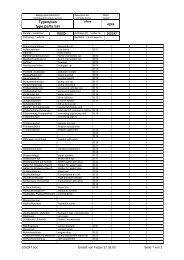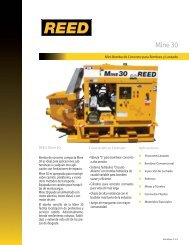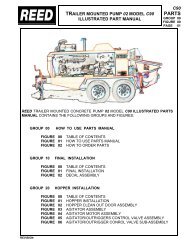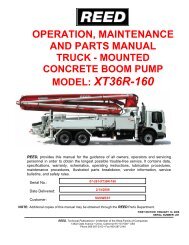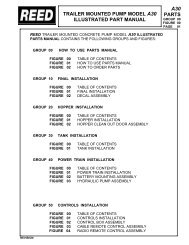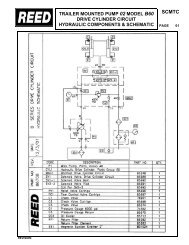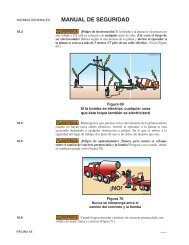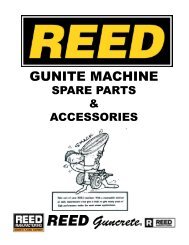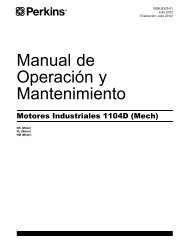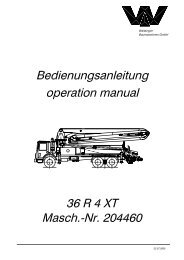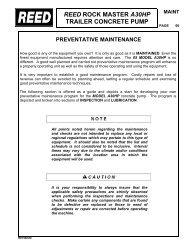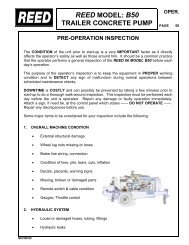Perkins Motor Operation and Maintenance Manual (English) - REED
Perkins Motor Operation and Maintenance Manual (English) - REED
Perkins Motor Operation and Maintenance Manual (English) - REED
Create successful ePaper yourself
Turn your PDF publications into a flip-book with our unique Google optimized e-Paper software.
SEBU8325-01 77<br />
<strong>Maintenance</strong> Section<br />
Walk-Around Inspection<br />
Walk-Around Inspection<br />
i02678854<br />
Inspect the Engine for Leaks <strong>and</strong><br />
for Loose Connections<br />
A walk-around inspection should only take a few<br />
minutes. When the time is taken to perform these<br />
checks, costly repairs <strong>and</strong> accidents can be avoided.<br />
Illustration 44<br />
Typical example<br />
(1) Belt tension gauge<br />
g01003936<br />
Fit the gauge (1) at the center of the longest free<br />
length <strong>and</strong> check the tension. The correct tension for<br />
a new belt is 535 N (120 lb). If the tension of the belt is<br />
below 250 N (56 lb) adjust the belt to 535 N (120 lb).<br />
If twin belts are installed, check the tension on both<br />
belts <strong>and</strong> adjust the tension on the tightest belt.<br />
Adjustment<br />
For maximum engine service life, make a thorough<br />
inspection of the engine compartment before starting<br />
the engine. Look for items such as oil leaks or coolant<br />
leaks, loose bolts, worn belts, loose connections <strong>and</strong><br />
trash buildup. Make repairs, as needed:<br />
• The guards must be in the correct place. Repair<br />
damaged guards or replace missing guards.<br />
• Wipe all caps <strong>and</strong> plugs before the engine is<br />
serviced in order to reduce the chance of system<br />
contamination.<br />
NOTICE<br />
For any type of leak (coolant, lube, or fuel) clean up the<br />
fluid. If leaking is observed, find the source <strong>and</strong> correct<br />
the leak. If leaking is suspected, check the fluid levels<br />
more often than recommended until the leak is found<br />
or fixed, or until the suspicion of a leak is proved to be<br />
unwarranted.<br />
NOTICE<br />
Accumulated grease <strong>and</strong>/or oil on an engine is a fire<br />
hazard. Remove the accumulated grease <strong>and</strong> oil. Refer<br />
to this <strong>Operation</strong> <strong>and</strong> <strong>Maintenance</strong> <strong>Manual</strong>, “Engine<br />
- Clean” for more information.<br />
Illustration 45<br />
g01003939<br />
1. Loosen The alternator pivot bolt (2) <strong>and</strong> the bolt<br />
(3).<br />
2. Move the alternator in order to increase or<br />
decrease the belt tension. Tighten the alternator<br />
pivot bolt <strong>and</strong> the link bolt to 22 N·m (16 lb ft).(1).<br />
Replace<br />
Refer to Disassembly <strong>and</strong> Assembly manual for more<br />
information.<br />
• Ensure that the cooling system hoses are correctly<br />
clamped <strong>and</strong> that the cooling system hoses are<br />
tight. Check for leaks. Check the condition of all<br />
pipes.<br />
• Inspect the water pump for coolant leaks.<br />
Note: The water pump seal is lubricated by the<br />
coolant in the cooling system. It is normal for a small<br />
amount of leakage to occur as the engine cools down<br />
<strong>and</strong> the parts contract.<br />
Excessive coolant leakage may indicate the need<br />
to replace the water pump seal. For the removal of<br />
the water pump <strong>and</strong> the installation of water pump<br />
<strong>and</strong>/or seal, refer to the Disassembly <strong>and</strong> Assembly<br />
<strong>Manual</strong>, “Water Pump - Remove <strong>and</strong> Install” for more<br />
information or consult your <strong>Perkins</strong> dealer or your<br />
<strong>Perkins</strong> distributor.



